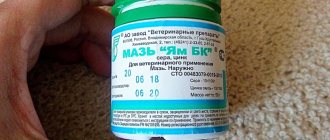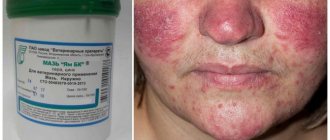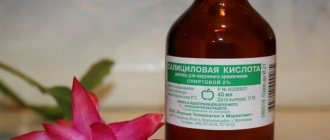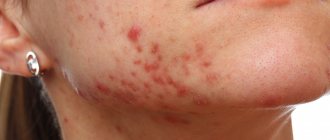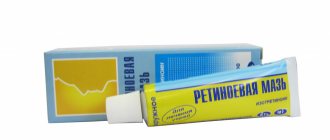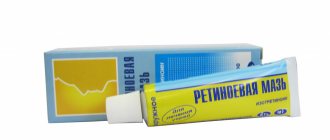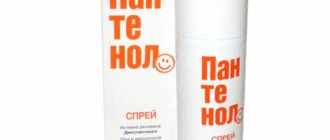Pharmacology offers many remedies for the treatment of skin pathologies. One of these drugs is salicylic ointment. It contains salicylic acid, which an Italian scientist synthesized from willow bark. Knowing the features of the drug, its capabilities, indications and contraindications for use, patients will be able to easily use the drug to treat the most complex ailments.
What is salicylic ointment used for?
Salicylic ointment is an antiseptic and anti-inflammatory agent, has powerful keratolytic properties (removes dead cells from the surface of the skin).
It is used to cleanse wounds; in dermatology it is prescribed for the treatment of skin diseases that are accompanied by inflammation and excess fat.
Salicylic ointment is often prescribed in complex therapy to patients with psoriasis. It is suitable for external use only, not for internal use.
Features of salicylic acid
The drug salicylic ointment is a dermatological product of the salicylic acid group of medications. This explains the pharmacological properties. When used topically, the composition exhibits weak antiseptic, irritating and distracting properties. Due to the ability to suppress the work of the sebaceous and sweat glands, the drug in low concentrations exhibits a keratoplastic effect, and in high concentrations it exhibits a keratolytic effect.
Salicylic acid has gained popularity and fame due to its ability to treat skin diseases. This compound is the basis of another drug - Aspirin; salicylates are also part of medicinal plants with antipyretic and anti-inflammatory properties. Acid is an essential ingredient in many skin and hair care products.
The ointment is applied externally and has a wound-healing and antiseptic effect. This medicine can be bought cheaply, and the low cost does not in any way affect the excellent quality of the drug.
Principles of the effect of salicylic acid (ointment) on the skin:
- Penetrates deeply in the local application area.
- It has the ability to suppress the activity of the sebaceous and sweat glands.
- Softens the top layer of skin and quickly eliminates deep inflammatory processes.
Salicylic ointment does an excellent job of cleansing purulent wounds. The ability to soften the top layer accelerates the process of cleansing lesions, and due to its irritating properties, blood flow to the wound is ensured, which leads to stopping the activity of pathogenic microorganisms and rapid healing.
Action and properties of the ointment
Salicylic acid (in other words, phenolic acid) was discovered in willow bark several centuries ago. It was she who became the predecessor of aspirin (acetylsalicylic acid), which is still actively used in medicine to treat a wide range of diseases.
By using salicylic ointment, you can speed up the healing of wounds, boils, pimples, blackheads, and soften growths and calluses on the skin.
Due to the pronounced keratolytic effect of the ointment, skin regeneration increases. Its antiseptic effect is widely used in the treatment of wounds and skin diseases accompanied by a violation of the integrity of the skin.
Salicylic ointment options
Salicylic ointment is produced in various concentrations : they all solve different problems. For each disease, the optimal percentage of salicylic acid in the ointment is selected.
The following options exist:
- 2-3% ointment: its main effect is drying, it is used more often in combination with other ointments and creams;
- 5%: helps in the treatment of burns;
- 10%: pronounced exfoliating effect, used to eliminate calluses and corns;
- 60%: intended for removing warts, it should be used only under the supervision of a doctor, as it has an aggressive effect due to its high concentration.
Indications for use of salicylic ointment
The drug is used both in monotherapy and in complex treatment for inflammatory, infectious and other lesions of the skin. The product is inexpensive, the price at the pharmacy will not make you empty your wallet, but at the same time the ointment really helps get rid of various problems.
Salicylic ointment is prescribed for diseases such as:
- Psoriasis, eczema (including weeping). The drug is also prescribed for dermatitis of varying severity.
- Ichthyosis, acne vulgaris, warts. The ointment is used in the treatment of oily seborrhea, focal dandruff, etc.
- Wounds, including purulent ones, with extensive lesions of the skin.
- Hair loss, sweaty feet.
External use and the lack of absorption into the systemic bloodstream allow the use of salicylic ointment to get rid of a wide variety of ailments. The only thing to consider is that the drug is available in different dosages. In particular, for the treatment of psoriasis they buy an ointment of 2-5%, for warts and calluses - 10%.
How to use
Those with problem skin can benefit from salicylic-zinc ointment with the addition of day or night cream.
To speed up skin regeneration, dexpanthenol can be used instead of regular cream. The mixture should be applied to problem areas of the facial skin for 2-3 weeks.
Salicylic ointment has a drying effect, which increases as the percentage of the product increases. People with dry and sensitive skin should use the ointment with caution, as additional discomfort may occur.
To remove calluses and keratinized skin, the course of treatment with 10% salicylic ointment is no more than 3 weeks: usually this time is enough to achieve results.
Before applying the ointment to the affected areas of the skin, they should be pre-treated.
In a gentle way, it is necessary to remove dead skin areas, burn blisters must be carefully opened and treated with an antiseptic.
Then a thin layer of ointment is applied, and this area of skin is covered with a clean napkin (preferably sterile if we are talking about burns). It is recommended to change the napkin daily.
In surgery , salicylic ointment is sometimes still used when it is necessary to clean the wound of purulent-necrotic masses. Apply ointment to the affected area and cover with a napkin, leaving it for 1-2 days.
Precautionary measures
Remember that there is a possibility of acid entering the general bloodstream, so special care should be taken when applying the ointment.
- Pregnancy and breastfeeding. In this case, you need to use a two percent ointment on strictly limited areas of the skin for a maximum of two weeks.
- Childhood. 1% ointment is suitable for infants, 2% of the substance is suitable for children under 12 years of age. The maximum dose of ointment is 1g for an area of 10 cm.
- Diagnoses such as anemia, ulcers and various kidney diseases are contraindications for the use of ointment.
For all other categories of persons there is a strict limitation - no more than 2 g per procedure and no more than 10 ml per day.
The course of treatment with salicylic ointment is a maximum of 21 days. By the end of the period, addiction to the active substance develops, which reduces the effectiveness of the drug. Therefore, it is worth contacting a dermatologist if cure does not occur.
- If the ointment gets into your eyes or other mucous membranes, rinse them immediately.
- If you swallow the ointment, rinse your stomach and immediately contact the clinic.
- It is strictly forbidden to apply salicylic ointment to moles, warts and the urogenital area.
Salicylic ointment for heels
Salicylic ointment is used to combat rough skin on the heels. It softens the skin and makes the upper layer of the epidermis more pliable.
The product can be applied even to places where there are deep cracks, since salicylic acid protects against inflammation, cleanses wounds and prevents bacteria from entering them.
From reviews of the use of salicylic acid for heels, it follows that it is best to use it in the form of long-term applications, applying ointment throughout the night .
The foot is wrapped in a napkin or placed in a plastic bag so as not to stain the bed while sleeping. The duration of treatment ranges from one week to three.
Ways to get rid of post-acne
The intensity of post-acne is directly related to the severity of acne. Therefore, it is important to work not only to eliminate the consequences, but also to prevent the appearance of new elements on the skin. It is necessary to fight acne itself, eliminating its main causes. If pimples appear again and again, the prognosis for post-acne treatment is questionable; inflammation will give rise to new scars. Therefore, work with an experienced dermatologist-cosmetologist is required.
Most of the work on restoring, smoothing the skin and eliminating scars is carried out by a cosmetologist, but certain activities can also be performed at home. Moreover, only an integrated approach will give the most maximum results.
What can you do at home?
At home, you need to help the skin recover; it needs building elements and proper nutrition. To regenerate the skin and form its structure, it is necessary to supply vitamins and minerals, protein as a source of amino acids for the construction of collagen fibers and the synthesis of hyaluronic acid, which moisturizes and gives the skin tone and smoothness.
In addition, omega acids are important, which are involved in cell renewal and form cell membranes. It is important to adjust your diet, eliminate as much processed foods as possible, food chemicals (dyes, preservatives, E-additives) and give up bad habits.
To prevent new acne and improve tone, nourish the skin, heal inflammation and small scars, pharmaceutical products will help. You can use 1% salicylic alcohol or boric acid and wipe the skin with it twice a day. Levomekol ointment works quite well in treating acne, suppressing inflammation and eliminating scars. Many people use bodyaga powder, which is diluted in water to a paste and applied to the affected area. But before using all these remedies, it is important to first consult with your doctor to prevent side effects and complications.
Skin care is complemented by serums, care creams (day and night) selected by a cosmetologist, as well as homemade peelings with fruit acids. They delicately exfoliate the skin, remove dead cells, and cleanse its surface.
Folk remedies are often used, for example, infusions of St. John's wort and chamomile, which have an anti-inflammatory, soothing, cleansing effect. You can freeze them and wipe the skin with the resulting ice cubes, further increasing blood circulation and capillary tone.
You can also use masks with blue clay. The recipe for making a mask is very simple: three tablespoons of powder are diluted in water to a paste, applied to the problem area for 20 minutes and then thoroughly washed off with water.
What treatment methods are used in a cosmetology clinic?
Although homemade recipes help in the fight against post-acne, you should not think that only through them you can eliminate all problems. Home methods act on the very top layers of the skin and reduce only minor defects.
Modern cosmetic procedures will help get rid of deep scars, pigmentation and unevenness. But don't expect instant results.
Treatment methods are selected individually and comprehensively. The more severe the initial problem and the wider the affected area, the longer the treatment will be.
To achieve maximum smoothness of the skin and an even complexion or eliminate blemishes on the body, you need a whole series of procedures, supplemented by home care and carefully selected cosmetics. On average, the first noticeable results will be visible after 1-2 months with regular implementation of all necessary treatment measures.
If there is unevenness, decreased skin tone, pigmented or stagnant spots, peelings . There are a lot of treatment options: these can be mechanical peels (compositions with herbs, small dense particles) and chemical peels (with retinol, glycolic, resorcinol or other compounds).
With mechanical peeling, the effect of cleansing and exfoliation is achieved due to the mechanical scraping of the particles included in the composition of the upper layer of skin with outdated epithelial cells.
With chemical peeling, a similar effect is achieved through chemical cauterization of the upper layer of the epidermis, which leads to its subsequent rejection with peeling.
The cosmetologist selects peelings to suit your needs and strictly follows all the rules for their implementation in order to achieve maximum effect and avoid side effects. On average, the first results are visible after 5-6 procedures.
A more effective analogue of peeling is laser skin resurfacing . The doctor performs the procedure with a special laser unit with a strictly specified wavelength in order to influence the skin at the required depth without damaging neighboring tissues. The laser beam cauterizes the skin, the treated areas are actively exfoliated, which allows stimulating the regeneration of new tissues, more even and smooth.
Check out our patient's review of laser facial resurfacing:
Photothermolysis is a more advanced method of laser skin treatment. The rays do not act as a continuous field, but as individual points - creating a mesh on the treated area. This is a fairly effective, but less traumatic effect; the rehabilitation period after such procedures is reduced.
dermabrasion is used to combat skin imperfections . This is the use of aluminum oxide powder under pressure or a special rotating abrasive disc for mechanical grinding of the skin, removing the upper layers of the epidermis from it.
Filler injections can help eliminate atrophic scars and dimples and smooth out the skin . They are inserted under the defect area, create additional volume, and lift depressed skin. The effect lasts up to 6-10 months (depending on the drug), then the injections are repeated.
Mesotherapy with drugs that stimulate collagen synthesis and epidermal renewal gives good results A series of microinjections are made into the surface layers of the skin with the introduction of hyaluronic acid, antioxidants, and vitamin components. The cosmetologist selects a specific drug depending on the tasks and the severity of skin defects.
Another method is ozone therapy . This is a technique of introducing a special oxygen mixture into a problem area through a series of microinjections. The composition helps saturate tissues with oxygen, stimulates blood circulation or lymph drainage, and epithelial regeneration.
If no other methods have produced a significant effect, surgical removal of scars can be used. The affected scar tissue is excised within the boundaries of healthy skin. The rehabilitation process is long, and the intervention itself can also leave scars in the future.
Post-acne treatment at Dr. Gruzdev’s clinic:
Chemical peeling The clinic offers gentle superficial peels: almond and glycolic.
More details
Laser resurfacing Impact of a laser beam on problem areas of the surface layer of the dermis.
More details
Biorevitalization A non-surgical technique for facial rejuvenation using preparations based on hyaluronic acid.
More details
Mesotherapy An injection technique for introducing “cocktails” into the skin based on vitamins, microelements, and amino acids.
More details
Salicylic ointment for pimples and acne
The advantage of using salicylic acid for oily and problem skin is that it removes excess secretion from the sebaceous glands and slows down its accumulation with prolonged use.
For this purpose, you need to select an ointment with a low percentage of the active substance and follow the instructions for use so as not to dry out the skin.
Salicylic acid will help make acne marks and acne less noticeable, and not just on the face. For the body, you should select a slightly higher concentration of ointment.
Contraindications and side effects
Salicylic ointment is a drug, so it has a number of side effects from taking it. For some people, its use is completely contraindicated.
Ointment is not prescribed for:
- renal failure;
- in case of allergies or individual intolerances;
- treatment of pathologies in infants (due to high skin permeability).
Caution should be exercised by pregnant and lactating women, as well as children: they should apply the ointment to the skin in a small amount (no more than 5 ml).
It is advisable to consult a doctor before doing this. It is not recommended to apply ointment more than 3% without first consulting a doctor
Phenolic acid ointment is well tolerated by most people without causing any side effects from use. allergic reactions occur : they are manifested by burning of the skin, redness, itching at the site of application of the product.
This reaction is due to increased skin sensitivity, as well as exceeding the dosage specified by the manufacturer. If the ointment gets on the mucous membranes, you need to rinse the affected area with running water.
